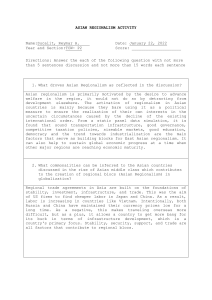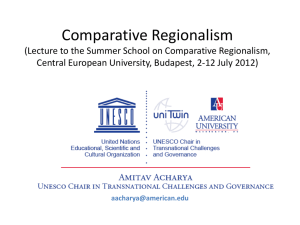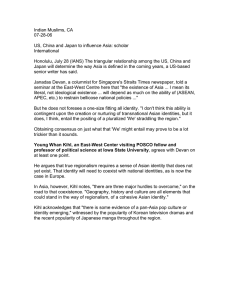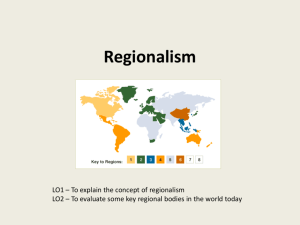The Impact of Global Credit Crisis on Asia*s Economic Integration
advertisement
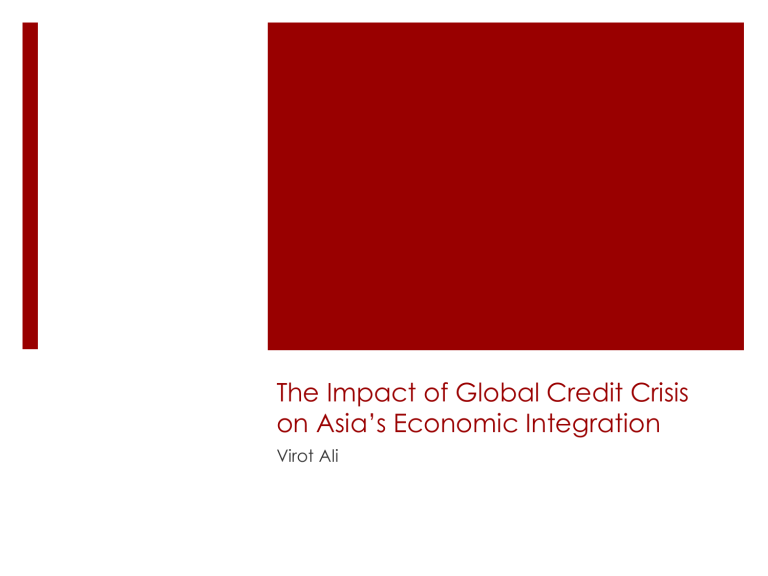
The Impact of Global Credit Crisis on Asia’s Economic Integration Virot Ali 5 Questions What is Regionalism? What was the impact of the 2007 economic crisis to East Asian economies? Why did the East Asian economies such as China and ASEAN resort to deeper integration as a response to the global financial crisis? Discuss the shortcomings that may hinder the evolution towards tighter integration in East Asia? In your opinion, what are the solution to the problem? Regionalism Large Market and Trading Bloc Strategy (Palan, 2001) Can we suggest that what we’re seeing in East Asia a Large Market Strategy? Impact of Global Financial Crisis (2007-2008) Financial Flow? Investments? Declining Exports? Growth in East Asia (2009 onwards) Industrial Production: i.e. automobile industry/Automobile sales in China Capacity Utilization: i.e. Thailand’s capacity utilization in vehicles, electronics and chemicals Exports: exports of China driven by demand outside East Asia; while Indonesia, Malaysia, Thailand and the Philippines exports were driven by regional demand; in 2009 China overtook Germany as the world’s leading exporter Growth in East Asia (2009 onwards) Capital Inflow; flows to China have surged. However, nonresident purchases of equities and government debt securities have increased. By contrast, inflows of foreign direct investment remain subdued and cross-border bank lending is only bottoming out. Local currency issuance has been the key tool to absorb liquidity. Investing abroad; for example, the $25 billion lent by China Development Bank to oil companies Rosneft and Transneft of Russia, and the $10 billion to the oil company Petrobras of Brazil, both to be repaid by oil shipments to China National Petroleum Company. Some Problems(2009) Crisis slowed the pace of poverty reduction in the region. Philippines have increased the poverty rate by as much as 2 percent. Changes in employment patterns; data suggests substantial movements out of occupations with relative high wages to ones with lower wages Challenges Fiscal Stimulus!: Fiscal easing helped limit the slowdown in economic growth across East Asia which, averaged 2 percent of GDP in 2009. Government led investments; China government-led investment was as much as 6 percent of GDP. Limit risks of asset price bubbles and overheating. The Chinese government, as a result, is limiting additional stimulus and projecting real GDP growth of 8 percent in 2010. Challenges Inflation; Signs of rising inflation after months of tranquility and robust economic recovery have led the monetary authorities in most countries in East Asia to begin tightening monetary policy. China’s monetary policy has led to strong credit growth in 2008 that boosted the stock of domestic credit to the highest levels in the region of about 140 percent of GDP. China’s central bank increased reserve requirements twice this year and is implementing a smaller quota level for bank lending aimed at slowing credit growth to 18 percent this year from 30 percent in 2009 Challenges Exchange Rates: Exchange rates in Indonesia, Thailand, Malaysia and Philippines have all recovered to their pre-crisis levels. Structural Reform? East Asia is poised to receive a larger share of the projected increase in global capital flows. East Asia received a fourth of global private capital flows in 2007 compared with nearly half for Europe and Central Asia. Despite a weaker global economy, East Asia still has the capability to grow strongly over the medium term. But this will not be easy to achieve and will not be automatic. Strong and inclusive growth will require renewed vigor in implementing key structural reforms in countries and at the regional level. Structural Reform? China: China’s rapid capital-intensive, exportoriented growth has been spectacularly successful. But the global markets it relied on will be weaker in the near future. The existing pattern of growth is energy- and natural resourceintensive, environmentally unsustainable, and does not create enough urban jobs. Structural Reform? Middle Income Countries: It is hard to overestimate the role dynamic manufacturing sectors have played in supporting economic growth in the region’s middle-income countries. For decades, the region has been the principal destination of large multinationals that invested in low value-added assembly production facilities, linking them in regional and global production networks. New policies are required to escape from the “crowded middle” of industrial development and break into knowledge- and skill- intensive sectors. Structural Reform Low Income Countries i.e. Lao, Vietnam, Cambodia: rising labor costs in China, improving regional transport links, and the rapid increase in the variety of “tasks” away from vertical integration has opened the potential for low income countries to break into manufacturing and become part of regional and global production chains. Where is Regionalism? Deeper Regional Integration: Is the “institution” the real problem? Intra-regional trade has risen fast, as an illustration of the advance of market-driven integration. Intra-regional trade accounts for 55-60 percent of total external trade of the East Asian countries, driven by intra-industry trade within regional and global production networks Trade facilitation: the logistics costs of transporting a container from Bangkok or Jakarta to Los Angeles is twice that of shipping it from Shanghai or Seoul. Where is Regionalism? Contrary to expectations, barriers to foreign direct investment in East Asia are the highest in the world The benefits from integrating trade in services and addressing technical barriers to trade cannot be underestimated. They are likely to be many times those from reducing border barriers. For example, static gains for developing East Asia and Korea from services liberalization are estimated at about $270 billion by 2015. Where is Regionalism? Developing East Asia is financially globalised but that less progress has been made towards financial integration within the region. Specifically, bond and equity markets in developing East Asia are weakly integrated, because of poor links between the financial infrastructure of countries in the region (such as payment, clearing and settlement), absence of harmonized standards, and unnecessary restrictions on access of foreign financial intermediaries to domestic financial markets. Any other things you’d like to add? Comments: Q & A

